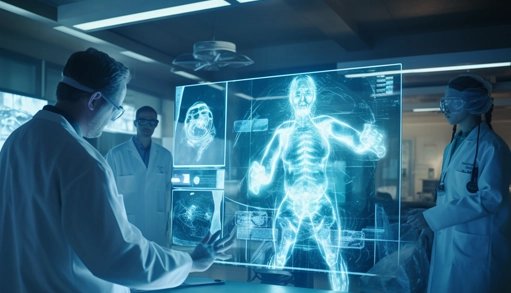
AI Trends in HealthCare
 Pasupuleti Brahma Teja
Pasupuleti Brahma TejaJunior Software Engineer

In healthcare, Artificial Intelligence has made its presence in medical specialties, including Radiology, Screening, Psychiatry, Primary Care, Disease Diagnosis, and Telemedicine. Reflections has developed state-of-the art models that help our customers excel in this industry by facilitating easier decisioning, faster diagnosis, explainable AI and computer-vision-driven analysis, quicker processing of large data sets revealing underlying patterns and history leading to the current symptoms, and digital twins super imposed with real-time information.
Artificial intelligence (AI) in healthcare is an umbrella term that describes the application of machine learning (ML) algorithms and other cognitive technologies in medical settings. In a scenario of mounting healthcare challenges, AI is adding new capabilities to the health sector with astonishing speed.
In healthcare, AI is not a new concept. From being used for the first time in the 1970s as MYCIN, an AI program that helped identify blood infections treatments, AI-powered applications have expanded and adapted to transform the healthcare industry by reducing spend, improving patient outcomes, and increasing efficiencies overall. Throughout 1980s and 1990s, the design of new AI systems helped achieve medical advancements such as:
- Producing faster data collection and processing
- Assisting in more precise surgical procedures
- In-depth DBA research and mapping, and
- More comprehensive implementation of electronic health records
Now, AI has made its presence in medical specialties, including Radiology, Screening, Psychiatry, Primary Care, Disease Diagnosis, and Telemedicine. AI is used in drug development, medical diagnostics, dosage error reduction, cancer research, personalized healthcare plans, virtual nursing assistance, fraud detection, cyber security, gene editing, AI robot-assisted surgery, rare disease diagnostics and treatment, health monitoring, and wearables.
AI trends are generally visible in the following areas:
- Healthcare Analytics
- Medical Diagnostics
- Telehealth
- Medical Robots
- Hospital Management
- Clinical Decision Support
- Clinical Trials
- Public Health Management
- Cybersecurity
- Personalized Healthcare
This blog examines in detail the application of AI in Healthcare Analytics, Medical Diagnostics, Telehealth, Medical Robots, and Hospital Management.
Healthcare Analytics
Healthcare data analytics utilizes Machine Learning algorithms to rapidly discern relevant information from large amounts of medical data. This enables early disease detection and timely intervention by analyzing data from electronic health records (EHRs), medical devices, and wearables. Startups develop predictive models to analyze patient datasets for the prevention of stroke, cardiovascular disease (CVD), neurodegeneration, and other complications among at-risk populations. Further, it forecasts hospitalization risks for chronic and critical patients to lower readmission rates. AI-powered big data further improves the overall accuracy and quality of care while speeding up drug discovery and development.
For example, German startup MedaPlus has developed an AI-assisted software platform for the analysis of respiratory and heart acoustic data. The startup’s stethoscope digitizer converts an analog stethoscope into a digital device that collects auscultation data. MedaPlus’ AI then analyzes the collected data and ECG readings to detect any abnormalities. Physicians and healthcare practitioners use the startup’s platform to offer data-driven predictive diagnostics, scale up their practice, and train respiratory specialists.
Another instance of AI being used in healthcare is the US-based startup Konplik Health’s proprietary software and medical data analysis tools for the healthcare sector. The startup’s platform leverages NLP algorithms to transform unstructured data from EHRs, social networks, and scientific literature into machine-readable formats. It then uses AI-driven predictive analytics to generate insights on medical treatments, hospital operations, and pharmacovigilance. Clinics and hospitals utilize it to improve efficiency and provide unbiased outcomes of clinical trials and drug development.
Medical Diagnostics
AI improves patient outcomes by providing faster diagnoses to support clinical decisions and reduce the risks of human error. Startups use a range of data processing methods, like ML and Deep Learning, to increase the capacity and streamline the workflows of radiologists. Examples include medical analysis of computed tomography (CT) scans and retinal images as well as electrocardiogram (ECG) waveforms and genetic testing. AI flags abnormalities and assists in the early diagnosis of rare medical conditions such as cancer and neurodegeneration. Moreover, it minimizes the need for unnecessary tests and procedures, consequently decreasing the burden on the healthcare infrastructure.
We can find another example in Hevi AI, a Turkish startup that provides hStroke, a plug-and-play AI-powered stroke triage solution. It examines brain-imaging scans utilizing deep learning algorithms to locate brain ischemia and haemorrhage for early stroke diagnosis. This reduces the time to identify acute stroke cases and it also sends alerts to physicians for starting treatments. That is why hospitals and radiologists apply it to automate stroke triage, reduce delays, and prevent patient disability.
Sierra Medical is a UK-based startup that makes patented software for early cancer diagnostics. The startup’s cloud-based software uses deep learning algorithms to detect pre-cancerous and cancerous cells in standard biopsies as well as generate tailored diagnostic reports. This allows diagnostic laboratories and healthcare providers to increase precision and reduce diagnosis time and costs.
Telehealth
Routine patient health and recovery monitoring allows medical professionals to focus on complex cases and emergencies. AI-driven virtual consultations and remote patient monitoring enables them to assist patients worldwide and provide data-driven care. E-health or mobile health (m-health) platforms range from simple recommendation engines and refer-to-specialist solutions to platforms that track and analyze patient health. Such solutions collect data from heterogeneous sources including electronic medical records (EMRs), medical images, wearables, medical devices, and smartphones. AI ingests this data to provide recommendations and alerts based on medical history, symptoms, and other concerns. Similarly, NLP-powered virtual health assistants and chatbots automate disease diagnosis, health monitoring, and triaging.
AS an example, Australian startup Smilo enables teledentistry by providing virtual consultations with dentists. The startup utilizes AI and smartphones to identify and remotely monitor oral health diseases. This allows physicians to build a patient-dentist relationship using two-way communication. It thus reduces healthcare costs by enabling early intervention for oral problems.
There is a Bulgarian startup Kelvin Health that has developed a mobile thermal imaging platform to detect vascular, inflammatory, and oncological abnormalities. It combines a thermo-camera to capture body heat images and thermography AI for segmentation and image analysis. The platform’s ML models analyze the images to detect different anomalies and alert medical specialists for preventive treatment. It also enables a portable, non-invasive, and self-application remote patient monitoring (RPM) and telemedicine solution for healthcare providers and clinicians.
Medical Robots
Medical robots provide healthcare facilities in remote areas or perform complex procedures with higher precision. Surgical robots assist surgeons in reducing the risk of complications and increasing the success rate of surgeries. Likewise, ML-based rehabilitation robots facilitate physical therapy for patients recovering from injuries or surgeries. Telepresence robots also utilize AI algorithms to simulate physical presence and provide care to patients in underserved areas. This improves patient monitoring for patients with infectious diseases and prescribed contact isolation. Also, startups use AI routing in medical transport robots and drones for the autonomous delivery of medical supplies and equipment.
US-based startup RIF Robotics offers an autonomous surgical tray assembler robot. It utilizes image segmentation and object classification ML models to identify, track, and assemble surgical tools. This way, the robot reduces the time for sterile processing and eliminates operating room delays dues to disinfection errors. The robot also automates medical equipment cleaning and infection tracking in hospitals.
Another US-based startup Oma Robotics enables robotics-powered single-cell fertility treatments. The startup’s AI sperm microscope technology facilitates the identification of the most suitable sperm cells during sperm selection. This increases the chances of pregnancy from intracytoplasmic sperm injection (ICSI), thus increasing the efficacy of in-vitro fertilization (IVF). Fertility service clinics and embryologists use the startup’s technology to enhance patient outcomes and reduce treatment costs.
Hospital Management
In hospitals, AI automates routine administrative tasks such as appointment scheduling, insurance claim processing, and medical inventory optimization. AI automation further tackles worker shortage and staff allocation while handling large patient volumes and keeping consistency in the quality of care. Additionally, startups utilize AI-based predictive modeling and patient flow management to optimize resource utilization and hospital operations. AI-driven hospital management and supply chain optimization software also offer targeted interventions and policies to improve the quality of care.
US-based startup MediCodio makes an eponymous medical coding as a service (MCaaS) software solution. It automates repetitive tasks such as data entry, patient EHRs logging, and patient chart retrieval. The software also collects patient information from EHRs and physician charts to suggest suitable medical codes for review and billing. Additionally, it integrates with existing workflows and improves the efficiency of medical coders, enabling faster medical and hospital software development.
Dyad, a UK-based startup provides a universal translator platform to streamline and improve visibility in hospital operations. It utilizes graph ML and semantic AI to centralize and standardize healthcare data from different departments at scale. The platform also features patient flow management, predictive purchasing, and revenue cycle optimization as well as curates a knowledge base for clinical research. This reduces resource wastage and operational costs while facilitating integrated primary and secondary care coordination in hospitals and clinics.
There are other areas like Clinical Decision Support, Clinical Trials, Public Health Management, Cybersecurity, and Personalized Healthcare where AI has been introducing drastic transformations, which we would discuss in the second part of this blog.
At Reflections, successfully driving our customers’ business growth through digital transformation, we have developed state-of-the art models that help our customers excel in this industry by facilitating easier decisioning, faster diagnosis, explainable AI and computer-vision-driven analysis, quicker processing of large data sets revealing underlying patterns and history leading to the current symptoms, and digital twins super imposed with real-time information. You can get in touch with us to understand more and explore possibilities and opportunities.
Authors:
Pasupuleti Brahma Teja, Junior Software Engineer
Mohamed Haseel, Associate Director, Digital Practice
